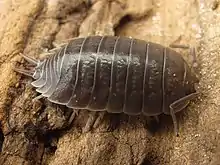Porcellio laevis
Porcellio laevis (commonly called the swift woodlouse, dairy cow isopod, or smooth slater in Australia) is a species of woodlouse in the genus Porcellio. As the species epithet laevis as well as the vernacular name "swift woodlouse" suggests, the species is capable of quick bursts of speed when provoked.
| Porcellio laevis | |
|---|---|
 | |
| Scientific classification | |
| Kingdom: | |
| Phylum: | |
| Subphylum: | |
| Class: | |
| Order: | |
| Suborder: | |
| Family: | |
| Genus: | |
| Species: | P. laevis |
| Binomial name | |
| Porcellio laevis Latreille, 1804 | |
This species of woodlice is distinctively large, appearing up to 20mm long with a smooth dorsal surface. The males can be identified by their long, spear-shaped uropods
Distribution and Habitat
Porcellio laevis was first recorded in Britain in the 13th century but it likely originated in North Africa.[1] It as has a cosmopolitan distribution,[2] and has been introduced to Australia, including Norfolk Island and Lord Howe Island.[3] The species is also found in North and South America, Western Asia, Japan, Australia and some Pacific islands.[4]
This species is found under rocks and fallen logs in damp areas, and is otherwise rarely encountered. Records from Ireland and Britain also place them in agricultural areas like gardens, farms, and stables where they can be found in dung and compost piles.
Development and Maternal Care
Porcellio laevis directly develop from yolky eggs. Both the eggs and juveniles develop within a brood pouch called a marsupium until the first juvenile stage.[5][6] The use of the marsupium eliminates the need for there to be an external water source for early development since it is filled with fluid from the mother isopod. This is considered some of the most extensive parental care among terrestrial arthropods.
References
- Harding, Paul (2016). "IS PORCELLIO LAEVIS (LATREILLE) DECLINING IN BRITAIN AND IRELAND?" (PDF). Bulletin of the British Myriapod & Isopod Group. 29.
- Michael C. Quinlan & Neil F. Hadley (1983). "Water relations of the terrestrial isopods Porcellio laevis and Porcellionides pruinosus (Crustacea, Oniscoidea)". Journal of Comparative Physiology B: Biochemical, Systemic, and Environmental Physiology. 151 (2): 155–161. doi:10.1007/BF00689913.
- "Porcellio laevis Latreille". Commonwealth Scientific and Industrial Research Organisation. November 11, 2004.
- Schmalfuss, Helmut (April 2016). "Two new species and new records of terrestrial isopods (Isopoda: Oniscidea) from Oman". Stuttgarter Beiträge zur Naturkunde A. 9 (1): 31–39. doi:10.18476/sbna.v9.a3. ISSN 0341-0145.
- Lardies, Marco A.; Cotoras, Ivania S.; Bozinovic, Francisco (2004-12-01). "The energetics of reproduction and parental care in the terrestrial isopod Porcellio laevis". Journal of Insect Physiology. 50 (12): 1127–1135. doi:10.1016/j.jinsphys.2004.10.005. hdl:10533/174983. ISSN 0022-1910.
- Csonka, Diána; Halasy, Katalin; Hornung, Elisabeth (2015-07-30). "Histological studies on the marsupium of two terrestrial isopods (Crustacea, Isopoda, Oniscidea)". ZooKeys. 515: 81–92. doi:10.3897/zookeys.515.9401. ISSN 1313-2970.
